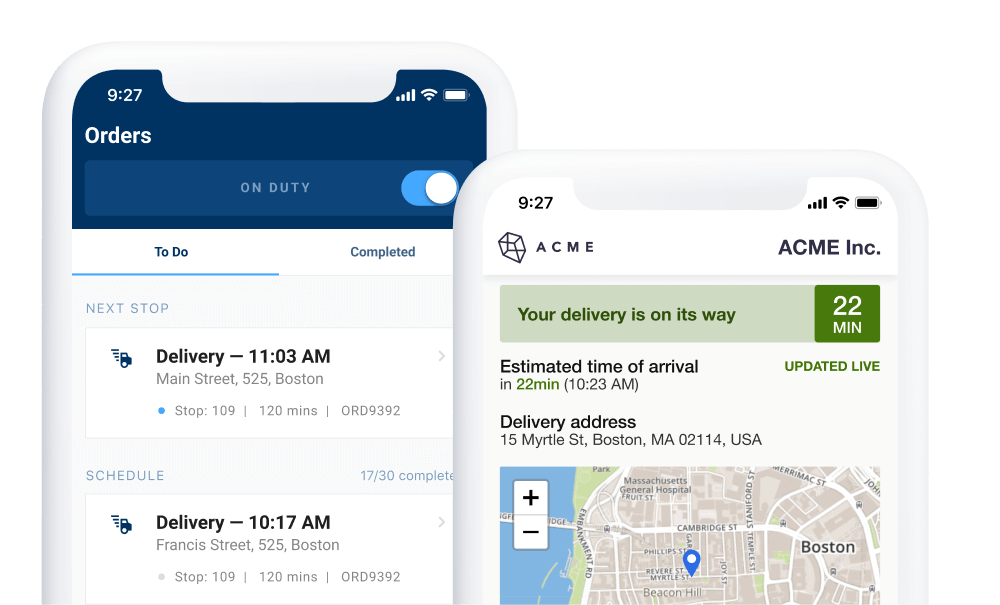What is Dispatch Management & How to Get More Out of Yours

Do you ever wonder what happens after you place a call for a service that you require? Who is in charge of decision making? How is a technician selected? Who calculates the route, travel time, traffic patterns? Where is the job status updated?
Well, the process that takes place before your field service technician arrives on location is actually called dispatch management or the process of optimizing how a company assigns and handles service calls and deliveries from start to finish.
If you are running a small business with only a few skilled workers, you might be able to organize this fairly quickly. But when a company handles hundreds if not thousands of orders per day, this process becomes impossible to handle manually.
And with ever-increasing customer expectations and growing demand for home deliveries and services, it’s more challenging than ever for a business to stay in control.
That’s why companies turn to dispatch management software. To optimize the dispatch process, increase a fleet’s capacity and handle more deliveries and service calls – there just is no simpler way.
So now that we know what dispatch management is, It’s important to also understand why efficient dispatch management is more important than ever. We’ll examine how to use it to improve your fleet’s productivity, and the role it can play in your business’ growth.
To navigate to the section which interests you the most, click below:
- What Is Dispatch Management?
- Why Dispatch Management Is More Important Than Ever
- Case Study: How ClearResult Revolutionized Their Dispatch Management Process
What Is Dispatch Management?
Dispatch management is the process of organizing, assigning, and optimizing the schedules and routes for workers within the delivery, maintenance, and service businesses. You can use any software, but companies most frequently turn to cloud-based solutions to ensure that teams can be as mobile as possible.
For instance, dispatch management oversees all vehicles leaving and coming back to the depot and everything in between. To the point, a business’ dispatch management directly impacts all the employees who are out in the field.
So optimizing routes and schedules can really make the difference and maximize deliveries, maintenance repairs, or service visits while driving down unnecessary costs to the company.

Reduce your operational costs by 30%
Increase delivery capacity by 43%
Plan 7x faster
Why Dispatch Management Is More Important Than Ever
With increasing customer expectations and other trends, efficient dispatch management is becoming more vital to your business’ growth than ever. Here are four top reasons why:
1. More Companies Offering Same-Day Delivery
More than (51%) half of retailers offer same-day delivery and 65% plan to offer it within two years. 49% of shoppers say that same-day delivery makes them more likely to shop online. So Not only do more and more consumers expect same-day delivery, more retailers are offering it than ever.

To remain competitive, you have to be able to move fast. Effective dispatch management is at the core of maintaining a fast delivery operation.
For field service businesses, being able to schedule technicians for last-minute service calls is also essential.
2. High customer expectations
According to a consumer study by Retail Touchpoints, 63% of consumers expect a standard delivery to arrive within three days. Another study found that 84% of all consumers are unlikely to shop with a brand again after a poor last mile delivery experience.
To keep customers and grow in the digital age, you can’t afford mistakes to slow down your delivery process.
3. High turnover rates
Transportation and field service (included under trade and utilities) have some of the highest rates of voluntary turnover. An average of 27.6% of all workers quit voluntarily each year.

Local delivery driver employers see even worse numbers. In 2019, Papa John’s had an annual delivery driver turnover rate of 220%. Papa John’s has been struggling to hire and retain delivery drivers, which make up 60% of its employee base, due to low unemployment and higher demand for drivers.
A great transportation dispatcher handles driver relations, and must, therefore, know how to recognize a good driver and keep them with the company for as long as possible. This involves maintaining balanced workloads, and optimizing schedules for your drivers.
4. Increasing price pressures
Increasing price pressure from competitors is cutting profit margins in the shipping, trucking, and delivery industries. In 2019, Inbound Logistics’ exclusive survey found that 38% of shipping companies faced this problem.
To keep a healthy profit margin at all times, you need to take all of these variables into account. It becomes clear that to maximize the output of your fleet of vehicles and drivers — like consistently getting more deliveries done daily without hiring more drivers you need a dispatch management system or software that is up to the task.
Case Study: How ClearResult Revolutionized Their Dispatch Management Process With OptimoRoute

Take for example CLEAResult. As an energy management company with clients ranging from residential buildings to large government agencies, they run a major recycling program for their clients, picking up thousands of appliances every month.
The sheer volume of trips and pickups represented a major reverse logistics challenge, and their operations specialist was struggling with outdated dispatch management software.
Christine Nelson, an Operations Specialist with ClearResult described the problem they were facing as “a school of hard knocks… Our first scheduling tool became so difficult to use that we were basically running everything off paper because it didn’t provide us with what we needed as the Appliance Recycling Program expanded.”
ClearResult handles over 3,000 recycling pickups per month, making manual planning next to impossible. The dispatch software they had been using required their dispatch management team to individually plan the route for each order.
With OptimoRoute, the day-to-day operations of the dispatch management team changed completely.
Here’s how they did it…
Step 1: Bulk importing of thousands of orders
Manually entering the addresses and planning routes was incredibly time-consuming, and a huge challenge for ClearResult’s team.
Because OptimoRoute allows bulk import of orders through Excel or CSV files, the dispatchers now spend a lot less time planning orders. This allows them more time to focus on high-level KPIs and keep the business running as smoothly as possible.
Step 2: Automatic optimization of routes with support for advanced variables
OptimoRoute’s route optimization algorithm doesn’t just find the fastest route between a number of destinations.
Dispatch managers set up service areas, and edit attributes for real world constraints like vehicle capacity, delivery time windows, driver work schedules, and more. Then, once a work order is imported, OptimoRoute automatically matches the most suitable driver with a particular task.
This meant dispatchers can quickly create efficient schedules and routes for all drivers in minutes, saving planning time, mileage, and overtime costs which dramatically cut down the required planning time for ClearResult’s dispatching team.

Step 3: Managing complex workflows and schedules
ClearResult has a unique pickup and delivery locations for each task, which OptimoRoute supports with unique locations set at the order level.
So, if you are planning long-distance routes, you can set a time-range for mandatory driving breaks for your drivers, and OptimoRoute will automatically fit breaks into schedules in an efficient way.
Step 4: Weekly planning and long-haul routing (and last-minute adjustments)
For companies with a large volume of daily orders (like ClearResult), it’s impossible to both plan in advance and adjust to last-minute cancellations and changes.
OptimoRoute is uniquely positioned to handle advanced use cases like this, with support for both weekly planning for up to five weeks and flexible rerouting that let you edit live routes and update the tasks on the driver’s mobile app.
Final Thoughts
Once you go beyond the scale of a few orders per day, dispatch management becomes a serious operational challenge.
If you don’t have the right people, tools, or processes in place, you won’t be able to meet rising customer expectations.
With OptimoRoute, even inexperienced staff can correctly dispatch, schedule, route, and control fleets with hundreds of drivers without issue.
Our software automatically schedules and routes your technicians or drivers, and supports advanced workflows and variables, drastically reducing the amount of manual work required.
To see how OptimoRoute can transform dispatching, scheduling, and routing in your company, start your free trial today.
Try OptimoRoute™ for Free
No installation or credit card required


